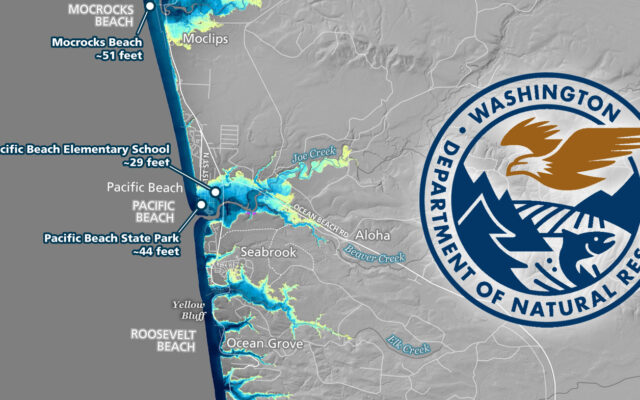New study details tsunami impacts of 9.0 earthquake on Olympic Peninsula

Following minor flooding along the Pacific Coast from a tsunami caused by an undersea volcanic eruption off Tonga over the weekend, a new study by the Washington State Department of Natural Resources (DNR) shows a much more significant impact from a magnitude 9.0 earthquake on the Cascadia subduction zone.
This study, prepared by geologists within the Washington Geological Survey division of DNR, was conducted to help develop preparation and response plans for those areas along the coast that a Cascadia earthquake and tsunami would affect. It builds on previous studies by the agency in recent years showing likely Cascadia tsunami impacts to the southern Pacific coast and for Puget Sound.
“While we were lucky to avoid catastrophe from this weekend’s minor tsunami on our coast, the danger should be front of mind and this report shows what we’ve long known. There won’t be time for our coastal communities to react after a major earthquake, so it’s vital we provide these detailed models and keep our communities safe when – not if – the next Cascadia mega-quake hits,” said Commissioner of Public Lands Hilary Franz.
The new modeling uses a simulated magnitude 9 earthquake on the Cascadia subduction zone. The last Cascadia rupture was 321 years ago, and experts estimate a 10 to 17 percent chance that Washington experiences another in the next 50 years.
Study tracks projected tsunami impacts from Grays Harbor to Port Townsend
The study finds the first tsunami waves would reach La Push within 10 minutes from the start of the earthquake, with the crest reaching many locations along the Pacific coast within 30 minutes. The first rising waves of the tsunami also travel into the Strait of Juan de Fuca, reaching Port Angeles about one hour after the earthquake.
Flooding depths on land are expected to reach or exceed 60 feet along most Pacific coast beaches.
The study finds inundation ranging from a high of about 100 feet at Yellow Banks Beach in Olympic National Park to about 5 feet at the New Dungeness Lighthouse at Dungeness. Other significant sites include Griffiths-Priday State Park at Copalis Beach at 53 feet, the Lower Hoh Tribal Center at 43 feet, and Discovery Bay at 33 feet. Several sections of State Route 112 and US Highway 101 would be made impassible.
The tsunami would first arrive as a trough, with sea levels gradually receding in all inner coastal waterway locations.
Currents from the tsunami would move swiftly, exceeding 9 knots off the coastline and within some areas along the Strait of Juan de Fuca, posting navigational hazard for the maritime community.
The model does not account for tide stages or local tsunamis triggered by earthquake-induced landslides. Local crustal faults may still represent a larger hazard for some communities.
This new study and maps are available alongside more tsunami information online at:
https://fortress.wa.gov/dnr/geologydata/tsunami_hazard_maps/ger_ms2022-01_tsunami_hazard_olympic_peninsula.zip (88.7 MB zip file)



